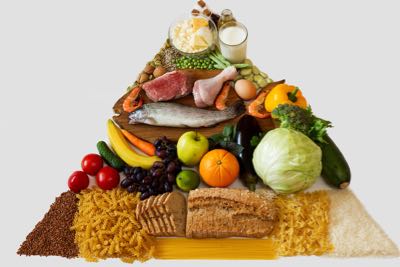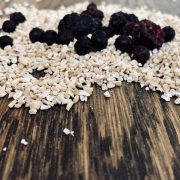What is a Healthy Diet? How to Eat Based on Science

Chances are good you, or the person next to you, dieted in the last year. Statistics show 49.3 percent of the population tried to lose weight by dieting in the last 12 months. Over the course of your lifetime, you’ve probably dieted at least five times—possibly more.
It makes sense. You live in a weight-obsessed culture. And, you know weight is closely linked to health. So, you try to lose the pounds. You may find yourself wondering, “what is a healthy diet”?
Paleo. Keto. Low-fat. Low-carb. Vegan. Fruitarian. Whole30. Wheat Belly. Jenny Craig. Dukan. Dubrow. Fit for Life. Carnivore. South Beach. Atkins. If you want to lose weight, you have a lot of choices. Each has its own pros and cons.
Here’s a sobering statistic: an estimated 95 percent of people who lose weight on restrictive, fad diets gain the weight back in one to five years. And, with all the different advice, it’s hard to know who to trust or how you should really eat.
Even if a restrictive diet fad helps you lose weight in the short term, is it a good idea to eat that way forever? To never give your body another carb? Or to stop eating fruit? Or to only eat fruit? What about loading up on butter and bacon?
It’s all mind-bogglingly overwhelming. And, looking at the statistics, it’s pretty hard to argue with the fact that fad diets simply don’t work. In the words of ‘90s fitness icon Susan Powter, it’s time to “stop the insanity.”
Say Farewell to Fad Diets Forever
Consider this: If it were impossible for your body to ever lose another pound, would that mean you should give up trying to eat healthier foods? Of course not.
Adopting short-term, fad diets for weight loss will almost always fail. The answer lies in turning your focus to eating for your health—for the rest of your life. It’s not restricting yourself for a short time because you’re trying to fit a number on a scale.
Health comes in all shapes and sizes. Regardless of your weight, you deserve to feel your best every day. Giving your body the nutrition that science has shown it needs to thrive comes with many rewards. You’ll glow with health. Your body will feel good. You’ll have plenty of energy. And, you’ll feel mentally and emotionally ready to tackle your goals and challenges every day.
Then there are the long-term benefits. Healthy eating patterns have been associated with maintaining the health of virtually every part of your body. This includes your heart, brain, bones and joints, and metabolic function, just to name a few.
The key to success is changing your behavior for a lifetime. Finding a way to eat that feels natural and that you can enjoy forever. A more positive relationship with healthy food will help you live a long, healthy life doing the things you enjoy with those you love.
Below you’ll read an overview of a healthy diet packed with foods science shows are most beneficial for health. You’ll also get guidelines and goals you can work toward to help you make a gradual, permanent shift in how you eat each day.
What is a Healthy Diet?
Most people have gotten it wrong. They eat foods that weigh them down and not enough of those that will help them live long, healthy lives.
A 2019 study found consumption of nearly all healthy food is below optimal levels. Researchers reported the healthy foods you don’t eat are as important, if not more so, as the unhealthy foods you may eat too often. They noted that “suboptimal diet is responsible for more deaths than any other risks globally, including tobacco smoking.”
Low intakes of whole grains and fruit were the worst offenders when it came to negative impacts on health. Not eating enough nuts and seeds, vegetables, omega-3 fatty acids, fiber, and polyunsaturated fats also had negative effects on quality of life. Overconsumption of salt was a serious issue for long-term health, too.
This study shines a light on what you need to add to achieve a healthy diet, instead of only focusing on what you need to cut out. Author Michael Pollan summed it up simply in his book, In Defense of Food, when he observed we should, “Eat food. Not too much. Mostly plants.”
Healthy dietary patterns are generally a variation of the Mediterranean diet (modeled after traditional dietary patterns from countries surrounding the Mediterranean Sea). These diets emphasize whole, minimally processed foods: vegetables, fruits, whole grains, beans, lentils, nuts, seeds, and beneficial fats (especially from extra virgin olive oil).
This type of diet can be adjusted to fit most dietary, cultural, or ethical preferences. It can be healthy with or without animal-based foods. Although, careful planning is often required to ensure vegan and vegetarian diets are complete and balanced. Many people find that having some meat in their diet helps manage hunger better. But it’s a personal choice only you can make. You may also opt for organic produce and grass-fed or pasture-raised animal products.
And, plain old water is best to quench your thirst.
Chew on the Science of a Healthy Diet
There is abundant evidence that sticking to a whole-food diet based on plant foods supports the health outcomes that matter the most. That means more years in your life and more life in your years.
A healthy diet provides many of the nutrients you need for wellness. This includes omega-3 fatty acids, fiber, and antioxidants—along with a range of vitamins and minerals—that work together to deliver major benefits for health. These benefits have been proven in many studies, in thousands of people.
A study of 23,153 Germans aged 35–65 found high intake of fruit, vegetables, and whole-grain bread, along with low meat consumption, was associated with improved health. The results were even more significant in those who maintained a healthy Body Mass Index (BMI), never smoked, and exercised for three-and-a-half hours or more per week.
A study conducted by the World Health Organization found it’s never too late to start eating better. They saw a two-year increase in life expectancy at the age of 60 in those who adhered to healthy dietary patterns.
Dozens of studies and clinical trials have shown a Mediterranean-style diet helps maintain:
- healthy waist circumference and body weight/BMI
- normal cholesterol
- healthy blood glucose
- normal blood lipids/lipoproteins
- healthy blood pressure and circulation
- normal cognitive function
The Lowdown on Glycemic Index and a Healthy Diet
Generally, a healthy eating pattern consists of food with a low glycemic index or load.
When it comes to the glycemic index, common sense should dictate your decisions. The goal is to limit nutrient-poor, processed foods with refined starches and sugars. Not foods from nature. Many starchy vegetables, such as carrots, and fruits have a higher glycemic index.
But there’s no evidence these foods are harmful.
In fact, a 2018 review showed dramatic benefits linked to eating multiple servings of whole fruit. This is thanks, in part, to their fiber content and prebiotic effects (i.e., how well they feed the good bacteria in your gut). Benefits were seen in cardiovascular, digestive, metabolic, respiratory, and bone health. Plus, eating fruit improved measures of psychological well-being and skin health, too.
A Day in the Life of a Healthy Diet (for Adults)
Now you’ve digested a good overview of what a healthy diet includes. So, let’s look more closely at how those foods could shape your daily eating.
The following standards reflect commonalities and differences of the most well-established healthy eating patterns. These include the Mediterranean diet, Dietary Approaches to Stop Hypertension (commonly called DASH), Mediterranean-DASH-diet Intervention for Neurodegenerative Delay (MIND), Flexitarian (or semi-vegetarian), and USDA Dietary Guidelines.
| Guidelines for a Healthy Diet | |
| Food Group | Number of Servings |
| Whole Grains | 6–8 per day |
| Vegetables | 5+ per day from a rainbow of colors
|
| Fruits | 3–5 per day
|
| Protein Sources | *Meet your target range in grams* (see below)
Aim to increase the protein you get from plant-based sources, including legumes and beans, soy foods (tofu, tempeh), unsalted nuts and seeds
If you eat meat, limit to 6 servings per week from a variety of sources:
|
| Dairy | 1–3 low- and non-fat dairy per day |
| Fats and oils | 2–3 teaspoons per day
|
| Sweets | Sparingly, should only be 5–10 percent of daily calories
|
| Beverages | Water, enough to stay hydrated (you may want to aim for 8 glasses a day)
Coffee and tea, as desired 1 serving wine/alcohol per day if desired |
| Salt | ~1 tsp TOTAL per day (this includes salt in prepared foods, so watch your food labels)
1,500–2,300 mg of sodium |
No foods are off limits—everything can fit into a healthy diet. But that comes with a stipulation: some foods should only be consumed on a very limited basis. Let’s call them “special occasion” foods.
Generally, special occasion foods are the worst for your waistline and your health. Truly savor them without guilt when you indulge. But reserve these foods for only a few times a month:
- Desserts and sugar-sweetened foods
- Chips and processed snacks
- Refined grains, like white bread or pasta
- Fried or fat-laden dishes
- Processed and cured meats (bacon, salami)
- Sodas or fruit juices
It’s all about finding the balance that works for you. To find what you enjoy, pay attention to the signals from your body, not just your taste buds. What does your body like? How do certain foods make you feel? Writing down the answers to these questions in a food journal can help.
Try new things, but don’t force yourself to eat foods you dislike. Your best diet is the one that’s made up of the healthiest, most nutritious foods you will love eating for life.
Mind Your Macros
Experts generally recommend certain ratios of macronutrients in your daily diet. Don’t get too hung up on the numbers. If you eat a healthy diet, like what’s listed above, you should be able to come close to these ranges with a little planning.
- 45–65 percent of your dietary calories should come from carbohydrates (mostly from whole grains, fruit, and vegetables)
- 25–37 grams of fiber per day
- Aim to consume .8 g–2 grams of protein for each kilogram (kg) of body weight, spread evenly throughout the day. (Mature individuals, people who want to lose weight, and very active individuals should consume protein at the higher end of the range.)
- To calculate your weight in kg, divide your weight in pounds (lbs.) by 2.205, then multiply that amount by .8 and 1.2 to get the range.
- For example, if you weigh 150 lbs.
- 150/2.205=68
- .8(68) = 54
- 2(68)=82
- Your range is 54–82 g protein per day
- 15–25 percent of your dietary calories should come from protein
- 20–35 percent of daily calories come from dietary fats
- Unsaturated fats should be 90 percent of dietary fat intake
- Saturated fats less than 10 percent of dietary fat intake
A Lifetime of Wellness Starts with a Healthy Diet
A healthy diet is only one of the eight pillars of holistic health and wellness. This article summarizes how variations of the Mediterranean diet are proven to support vitality and well-being. Other aspects of the Mediterranean culture are also essential parts of a healthy lifestyle: getting plenty of exercise and adequate rest, along with maintaining strong social relationships.
Each day and every meal are full of chances to make good choices. Establishing positive habits is the key to long-term success. So, commit to saying farewell to fad diets forever and breaking the cycle of unhealthy eating. Start by setting small goals and use the science of self-motivation to begin your journey toward a lifetime of good food and good health today.
To learn more about how to adopt a healthy, whole-food diet, download the USANA® Food Guide. Inside, you’ll find a list of healthy foods, smart swaps, a week of sample menus, and serving sizes. There’s also a suggested shopping list, along with blank shopping lists and meal planning worksheets, and much more.
References
https://foodinsight.org/fast-take-how-is-what-were-not-eating-affecting-our-health/
https://www.ncbi.nlm.nih.gov/pubmed/30954305
https://foodinsight.org/webinar-what-are-the-influencers-that-impact-how-why-people-eat-2/
https://www.health.harvard.edu/staying-healthy/healthy-eating-plate
https://www.ncbi.nlm.nih.gov/pubmed/27507131
https://academic.oup.com/ajcn/article/101/6/1317S/4564491
.https://www.hhs.gov/fitness/resource-center/facts-and-statistics/index.html
https://www.who.int/news-room/fact-sheets/detail/healthy-diet
https://www.ncbi.nlm.nih.gov/pubmed/25318818
https://www.ncbi.nlm.nih.gov/pmc/articles/PMC4085191/
https://www.annualreviews.org/doi/full/10.1146/annurev-publhealth-032013-182351#_i12
https://www.ncbi.nlm.nih.gov/pubmed/30487459
https://www.cnpp.usda.gov/sites/default/files/nutrition_insights_uploads/Insight49.pdf
http://www.grubstreet.com/2018/03/ultimate-conversation-on-healthy-eating-and-nutrition.html
https://www.ncbi.nlm.nih.gov/pubmed/28292617
https://www.ncbi.nlm.nih.gov/pubmed/25432391
https://www.healthlinkbc.ca/health-topics/ad1169
https://health.gov/dietaryguidelines/2015/guidelines/chapter-1/key-recommendations/
https://jamanetwork.com/journals/jama/fullarticle/1730520
https://www.ncbi.nlm.nih.gov/pubmed/23093136
https://www.ncbi.nlm.nih.gov/pmc/articles/PMC3135022/

















